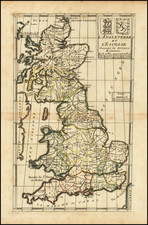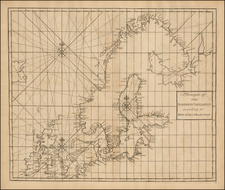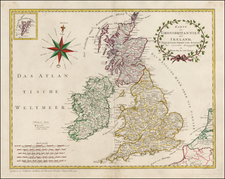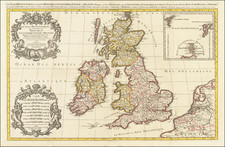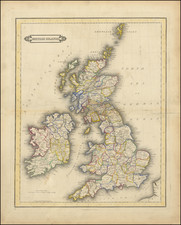Striking example of Marcus Willemsz Doornick's rare broadside plan and view of the Great Fire of London (1666), including panels of text written in 3 languages.
This rare broadside map of London shows the city after the Great Fire of 1666, and is one of the most detailed and finely presented visual records of that momentous event. The main map extends from Shoreditch in the north, to Lambeth in the south, and from Westminster-St James's in the west, to Wapping in the east. It shows the streets of London in great detail, clearly indicating the vast expanse of the city that was consumed by the conflagration. Text panels, written in three languages (Dutch, French and English), describe the nature of the fire and contain a key identifying 97 points of interest throughout the city (labeled A-C, and 1-93).
Beneath the main map, shown draped on a curtain, is an inset perspective view of the city, entitled "Londons Brandt", showing the city ablaze with flames towering above the ill-fated medieval St Paul's Cathedral.
The top left corner features a proposed plan of the rebuilding of the destroyed area, the "Nieuw Modell", which replaces the ancient warren of irregular streets with a street plan of wide, right-angular thoroughfares and spacious public squares. This design was concieved by Robert Hooke (1635-1703), the brilliant scientist and natural philosopher, who, following the fire, was appointed Surveyor of London. The map's general title appears on a banner at upper right flanked by the Royal arms and the arms of the City of London.
The Great Fire of London was one of the most consequential events of the 17th-century. The conflagration started in a bakery on Pudding Lane and raged from September 2-5, 1666 (September 12-15, according to the contemporary 'Old Style' calendar). The city then consisted largely of timber and thatch medieval buildings that, after one of the hottest and driest summers on record, went ablaze as if they were kindling. Almost 90% of the City of London within its old walls was destroyed, 13,200 homes were burnt to the ground and 70,000 of the city's 80,000 residents were left homeless. Many of the head offices of England's major trading companies were destroyed, and the dislocation severely hindered England's economy.
The event could not have occurred at a worse time, for England was then doing battle with both the Netherlands and France, in the midst of the Second Anglo-Dutch War (1665-7). Up to the time of the fire, the English were winning the war, but the calamity curtailed her military capabilities, and this was, in part, responsible for allowing the Dutch Navy to sail up the Medway to burn the Chatham naval shipyard in June 1667, one of the most humiliating defeats in the history of the Royal Navy. This ensured that the war was soon concluded on terms highly favorable to the Dutch.
While several well-conceived plans were proposed for the rebuilding of London on rational geometric patterns (such as the aforementioned Hooke plan), Charles II rejected these designs and ordered London to be rebuilt on its ancient street pattern. That being said, the process of renewal gave rise to the great era of English Baroque architecture, epitomized by Sir Christopher Wren's new St. Paul's Cathedral (completed 1720), which now dominates The City. It also led to improved building standards and fire prevention programs which ensured that a large accidental conflagration would never occur in Britain.
Doornick's trilingual broadside was ingeniously designed to appeal to commercial markets in three nations. The English were naturally interested in the fire as the transformative event of their generation, while the Dutch and French public were curious about the fate of the capital city of their military foe.
The present broadside is very rare, we are aware of it appearing at auction or in dealers' catalog only twice in the last 25 years. The low survival rate of 17th-century broadsides is accounted for the fact that they were treated as ephemera, and were prone to damage upon handling, leading them to be discarded. The present map is a rare survival of the most detailed and visually engaging records of the Great Fire of London.









